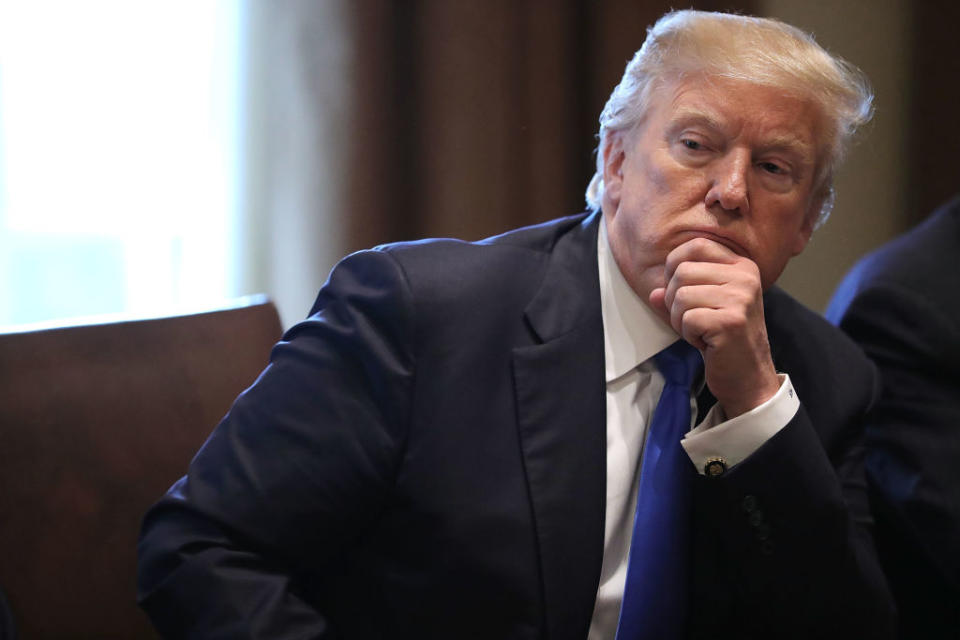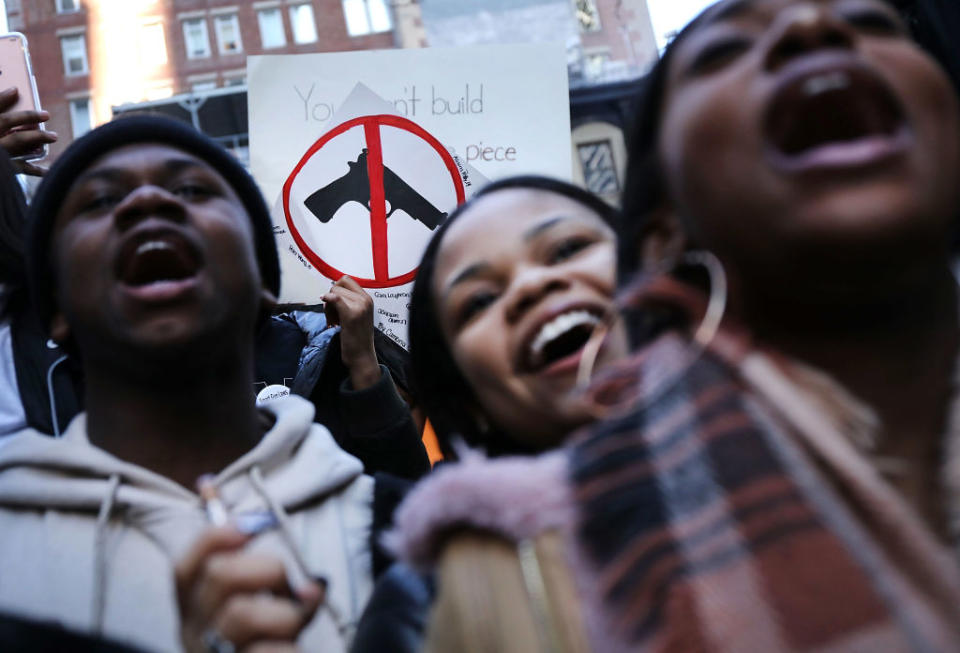Why Trump's latest plan to reduce gun violence could instead promote racism
After first signaling that he would support increased gun-safety regulations in the wake of the deadly Parkland, Fla. shootings last month, President Donald Trump is now changing his focus to that of school disciplinary measures — namely, rolling back Obama-era guidelines that were designed to reduce racial bias in how students are punished.
But critics say of this new idea say not only will it fail to reduce school gun violence, but it also will encourage an approach to discipline that has been shown, in study after study, to be racially biased, with black students bearing the brunt of punishments.

“There is no connection at all between the shooting and disciplinary policies,” Scott Sargrad, managing director for think tank Center for American Progress’s K-12 education policy, tells Yahoo Lifestyle. “And especially not with schools moving towards more positive approaches to behavior.” Furthermore, “ignoring the wide racial gaps in school discipline is incredibly misguided,” warns the former Obama administration Department of Education policy expert.
That’s particularly clear when examining the evidence. A 2014 report from the Department of Education, for example, found that even though black students make up only 18 percent of preschool enrollments nationally, nearly half of all preschoolers suspended from school during the 2011-2012 school year were black. And these numbers are likely to be even higher, because many preschoolers attend private preschools that are not required to report suspensions and expulsions. The data was confirmed by an analysis of data from the 2016 National Survey of Children’s Health by the Center for American Progress, a progressive think tank. The think tank found that black preschool students are 2.2 times more likely than other children to be expelled.

A September 2016 study by researchers at Yale University’s Child Study Center found that early education staff tend to observe black children — and especially black boys — more closely when challenging behaviors are expected, and that white preschool teachers have lower expectations for the behavior of their black students versus their white students.
Such findings are what contribute to the so-called preschool-to-prison pipeline, or the documented trend that the suspension or expulsion of young students leads to those same students being more likely to drop out of or fail high school, and wind up incarcerated later in life.
But preschool, of course, is not where problems of racial bias in school discipline end.
In the K-12 environment, the Obama administration’s U.S. Department of Education’s Office for Civil Rights found that black students are suspended and expelled at a rate three times greater than that of their white peers, with young women of color faring the worst of all. Even though boys receive more than two-thirds of all suspensions, black girls are suspended at higher rates than girls of any other race and most boys.
The discrimination experienced by students of color isn’t limited to just school-specific discipline, either. Black students comprise only 16 percent of enrollees in American public schools, but represent 27 percent of students referred to law enforcement by faculty and administration and 31 percent of students subjected to school-related arrest. In comparison, white students comprise 51 percent of enrollees, 41 percent referred to law enforcement and 39 percent arrested.
Experts at the Center for American Progress point out that the Obama-era guidance seeks to rectify these injustices. They further say that accusations of governmental overreach in regard to the guidelines are misinformed, as they did not establish any new mandatory laws or policies — just suggestions and resources.
The guidelines certainly did not cause the Parkland, Fla., shooting, Sargrad says.
He points to a report released by the Center for American Progress in January that found huge racial disparities in terms of who was disciplined at the two largest school districts in the United States — New York City and Los Angeles. The report found that although white students make up 15 percent of the New York City district and account for only 8 percent of suspensions, African-American students there comprise 27 percent of the district, but account for 47 percent of suspensions. The numbers were similar in Los Angeles, where African-American students comprised just 8 percent of enrollment, but accounted for 39 percent of days suspended.
“Students subject to these kinds of measures and who interact with the criminal justice system while in school are less likely to have success after high school,” Sargrad says. This means that if black students are disproportionately being targeted by zero-tolerance behavior measures, they are also being disproportionately set up for less success in life, often leading to incarceration.

“The main issue when we talk about the school-to-prison pipeline is that there is an overreliance on punitive policies, particularly in districts with high proportions of students of color. These students are more likely to have law enforcement involved, even in minor disciplinary infractions, including the criminalization of even minor disruptions,” he says. “They are more likely to drop out of school altogether. They’re less likely to go to college. They’re less likely to get a job. And then they are more likely to become chronically connected to the criminal justice system.”
Sargrad wrote in a brief just last week that Broward County, where Parkland’s Marjory Stoneman Douglas High School is located, changed its disciplinary policies to move away from traditionally discriminatory zero-tolerance practices in 2013 — a full year before the Obama administration guidance was issued. The district opted to reduce suspensions, expulsions, and arrests by implementing a new program that involved referring students to counseling services — successfully reducing arrests by two-thirds, with 90 percent of students who received counseling services not repeating the behavior for which they entered the program.
Sargrad also noted in his brief that the Obama-era guidance in no way serves as an infringement on law enforcement’s work. Had the shooter been arrested during a school-related incident — without a felony conviction or involuntary commitment to a mental health treatment facility — that still would would not have prevented him from legally buying a gun.
Last, Sargrad points out, the Parkland shooter was transferred from Marjory Stoneman Douglas to alternative schools multiple times — effectively an expulsion by another name. These measures did not prevent the shooting from happening but also probably “further alienated him, as he returned to the school that removed him to commit mass murder,” he writes.
“Parents need to talk to school and district leadership and ask, ‘Are you suspending for things like tardiness? Do you have consistent policies for things like talking back to teachers?’ Those types of policies can be really important to reduce the kind of bias inherent in the system,” Sargrad says. “Because this kind of systemic bias does exist and exists throughout all school districts everywhere … I think right now it’s unfortunate that this issue is being used as a distraction from the work of gun violence prevention.”
Read more from Yahoo Lifestyle:
‘I can’t buy a Kinder egg but I can buy an AR-15’: NYC students protest gun laws on walkout day
Famed trauma therapist responds to allegations of bullying: ‘It’s an outrageous story’
Gina Haspel is the CIA’s first female director — why aren’t more female agents getting promoted?
Follow us on Instagram, Facebook, and Twitter for nonstop inspiration delivered fresh to your feed, every day.

